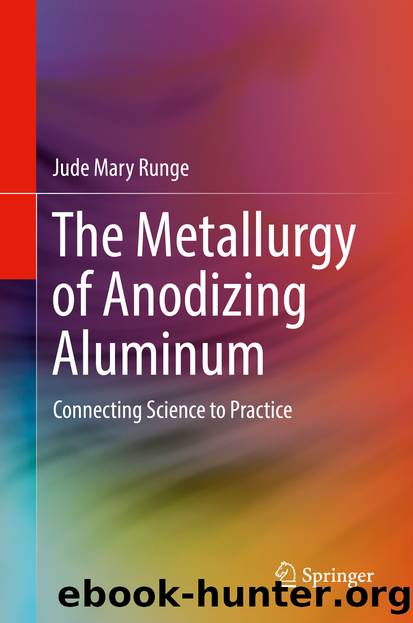The Metallurgy of Anodizing Aluminum by Jude Mary Runge

Author:Jude Mary Runge
Language: eng
Format: epub
Publisher: Springer International Publishing, Cham
4.4 Microstructural Development in Wrought Aluminum Alloys
Wrought alloys are designed to be deformed and therefore must possess a minimum ductility commensurate with the manufacturing process under consideration for engineering application [14]. Common bulk deformation processes are: forging , extrusion , rolling , and drawing. All deformation processes involve the pushing, pulling, hammering, or rolling of material over or through a tool or die to a desired fixed shape, thickness, or cross section. Whether a hot or cold process, the material responds to deformation by flowing in the direction of the applied force, or by cracking. When the bulk of any component is deformed and the material flows, the surface of the component is affected, whether or not the material comes in direct contact with the tool.
The starting point for deformation processes to produce a manufactured, wrought component is typically a cast billet or cut-to-size log or slab which is deformed to desired tolerances or for further deformation and finishing. Consequently, the microstructure of the billet directly impacts the quality of the wrought product. The speed and friction between a tool or a die and the component profoundly affects the surface of the component, introducing strain energy that provides the driving force to mechanically and thermally alter the microstructure. Microstructural development, together with the corresponding mechanical and chemical properties, continues throughout the manufacturing process. As the metal flows in the deformation direction, microstructural changes occur with the applied stress and through excursions over elevated temperatures that orient the grain structure, enable recovery and recrystallization , causing both grain growth and precipitation of intermetallic particles . See Fig. 4.15.
Fig. 4.15Microstructure development of a 6XXX alloy through deformation by way of roll forging [3]
Download
This site does not store any files on its server. We only index and link to content provided by other sites. Please contact the content providers to delete copyright contents if any and email us, we'll remove relevant links or contents immediately.
| Electricity | Magnetism |
The Complete Stick Figure Physics Tutorials by Allen Sarah(6632)
Secrets of Antigravity Propulsion: Tesla, UFOs, and Classified Aerospace Technology by Ph.D. Paul A. Laviolette(3432)
Thing Explainer by Randall Munroe(3319)
The River of Consciousness by Oliver Sacks(2989)
The Order of Time by Carlo Rovelli(2708)
I Live in the Future & Here's How It Works by Nick Bilton(2520)
A Brief History of Time by Stephen Hawking(2471)
How To by Randall Munroe(2466)
The Great Unknown by Marcus du Sautoy(2180)
What If?: Serious Scientific Answers to Absurd Hypothetical Questions by Randall Munroe(2166)
Blockchain: Ultimate Step By Step Guide To Understanding Blockchain Technology, Bitcoin Creation, and the future of Money (Novice to Expert) by Keizer Söze(2134)
Midnight in Chernobyl by Adam Higginbotham(2075)
Networks: An Introduction by Newman Mark(1994)
The Meaning of it All by Richard Feynman(1905)
Easy Electronics by Charles Platt(1859)
The Tao of Physics by Fritjof Capra(1842)
When by Daniel H Pink(1771)
Midnight in Chernobyl: The Untold Story of the World's Greatest Nuclear Disaster by Adam Higginbotham(1770)
Introducing Relativity by Bruce Bassett(1751)
